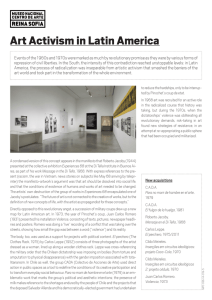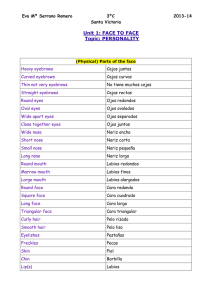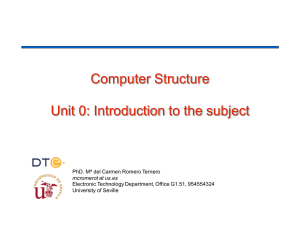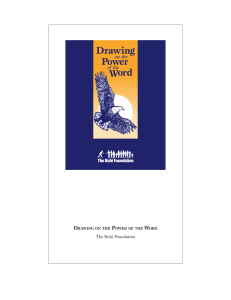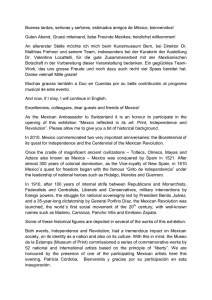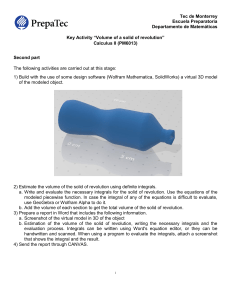Mi Caballo, Mi Perro y Mi Rifle Analysis: José Rubén Romero
Anuncio
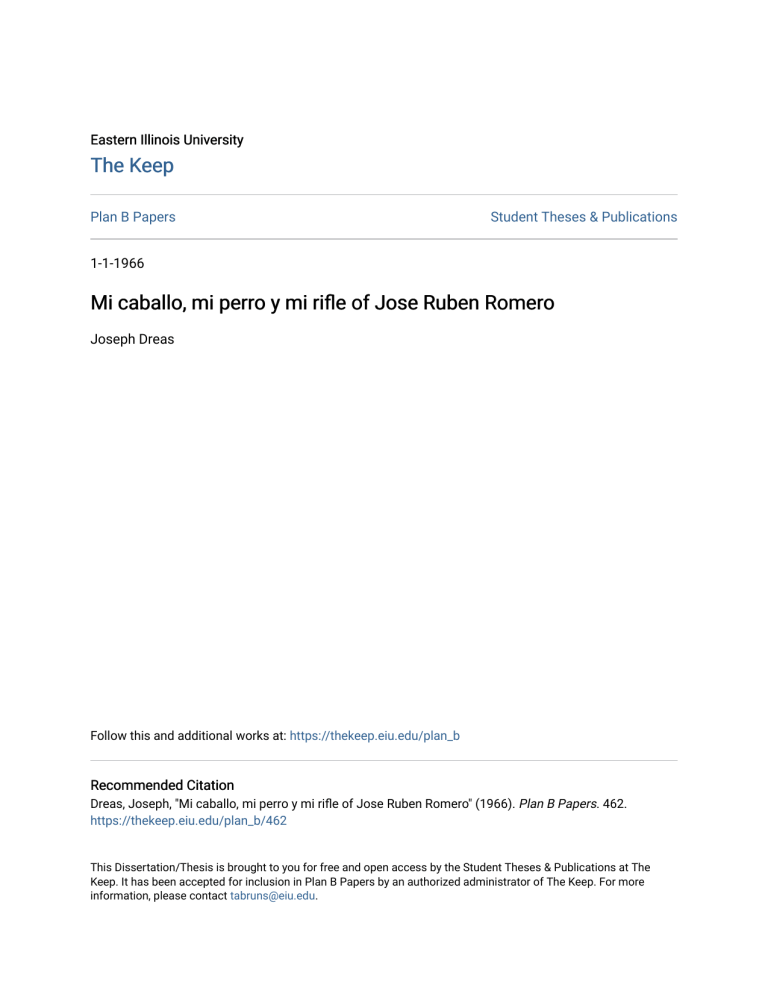
Eastern Illinois University The Keep Plan B Papers Student Theses & Publications 1-1-1966 Mi caballo, mi perro y mi rifle of Jose Ruben Romero Joseph Dreas Follow this and additional works at: https://thekeep.eiu.edu/plan_b Recommended Citation Dreas, Joseph, "Mi caballo, mi perro y mi rifle of Jose Ruben Romero" (1966). Plan B Papers. 462. https://thekeep.eiu.edu/plan_b/462 This Dissertation/Thesis is brought to you for free and open access by the Student Theses & Publications at The Keep. It has been accepted for inclusion in Plan B Papers by an authorized administrator of The Keep. For more information, please contact [email protected]. Analysis o:f Mi caballo, mi perro y mi rifle o:f Joa~ Ruben Romero (TITLE) BY Joseph Dreas PLAN B PAPER SUBMITTED IN PARTIAL FULFILLMENT OF THE REQUIREMENTS FOR THE DEGREE MASTER OF SCIENCE IN EDUCATION AND PREPARED IN COURSE Spanish 458 IN THE GRADUATE SCHOOL, EASTERN ILLINOIS UNIVERSITY, CHARLESTON, ILLINOIS 1966 YEAR I HEREBY RECOMMEND THIS PLAN B PAPER BE ACCEPTED AS FULFILLING THIS PART OF THE DEGREE, M.S. IN ED. May 13, 1966 DATE May 13, 1966 DATE DEPARTMENT HEAD Table or Contents Page I. Introduction ••••••••••••••••••••••••••••••••••••••• a. Short biographical data concerning the author b. Literary period to which he belongs l II. Summ.ary of the plot •••••••••••••••••.••••••••••••••• 3 III. Ailal7si s ••••••••..••••.•.•.•••.••.•.••.•••.•••.•••• 5 IVl Evaluation •••• • • • • • • • • • • • • • • • • • • • • • • • • • • • • • • • • • • • • • 15 V. Bibliography ••••••••••••••••••••••••••••••••••••••• 16 Introduction Jose Rubin Romero was born in the small Mexican village of Cotija de la Paz, in the state of Michoac6.n in the year During his life, he served in many and varied govern- 1890. mental offices in M6xico acting as recipient of rents, general inspector of Foreign Relations and Communications, head of the Publicity and Administrative Departments, director of the Census Office, private secretary to doctor Miguel Silva, governor of the state of Michoacan, and member of the Academia Mexican& .!!_ !!. Lengua. Be also held important offices abroad, such as consul general to Barcelona and ambassador of M&xico to Brazil and Cuba, and he worked closelJ>With the leaders of his time. During the Mexican revolution he assisted in the overthrow of the regime of Porfirio Diaz, and he was a conspirator and guerrillero during the dictatorship of Victoriano Huerta.l Romero began his literary career in 1922 with a book of poetry titled Tacimbare (Mexico, 1922). Nevertheless, Roaaero gained renown in the novelistic vein where he produced his beat works. writings: His novelistic production consists of the following Apuntes !!. ~ l:ugareno (1932), Desbandada (1934), El pueblo inocente {1934, !!!_ caballo. !!!_ perro ~ z ~rifle (1936), !.!.. Pi to Perez (1938), Antieipaci6n !. ~ muerte ~ .!!!. !,!!!. £!£2. ( 1942 ) , and Rosenda ( 1946 ) • The t ir st !!!!, inutil ( 19 39 ) , lA. Castro Leal, ed., Joa& Rubin Romero, Obras oompletas (M&xico, 1963), pp. 14-18. -2- four novels (1932-36) deal with the Mexican Revolution. At the beginning of the present century, there appeared a group of Mexican novelists, who were united among themselves in their theme: the Mexican Revolution of 1910. The historical events of that time influenced the writers of that period, and other novels which dealt with the Revolution from different points of view, continued to appear during the following years. Mariano Azuela, with his novel Los de abajo, published in 1916, is the initiator of the novela !_!. !!, revoluci6n. Other distinguished novelists are Martin Luis Guzman, Rafael Munoz, and Nellie Campobello.2 Jose Ruben Romero belongs to this group of writers who follow the path established by Azuela, and he occupies an outstanding place in relationship to other Mexican writers who wrote the novela ~ !!. revoluci6n. 2For more information concerning these authors, consult: A. Castro Leal, ed., La novela d• la revolucion mexicana (Mexico, 1960). - · -3Summary or the Plot In the year 1936, while Romero was in Barcelona, he published !!.!:.. caballo, !!.t perro z !!!.. ritle.3 This novel tells the story of Juli6.n Osorio, who is grief-stricken by the bitterness or life. Julian's mother had married a man twenty years her senior for the improvement of her own family's economic conditions. Aa he had grown older, she developed an affection toward him, and she assumed the business of the hacienda, conducting her affairs with real de~terity. All her hopes were centered on her only son Juli6n, who had suffered from infantile paralysis as a young child, and was unable to experience normal play activities with other children. In addition to this handicap, Julian belonged to the lower economic class, and he was therefore mistreated and scorned upon by his well-to-do classmates at school. As time went on he married Andrea _...., ld:'s mother 1 s close friend who was almost as old as she -- not because he loved her, but because be wanted to give their child a legitimate name. Julian felt an affectionate love for their son, but not for Andrea. He was so discontented with,his marriage that he went to work in a sugar mill, and later, rejoiced at the opportunity to join forces with the revolutionists in their struggle to overthrow the corrupt cacigues who were in power. Ignoring the pleas of Andrea ~o come home to his dying mother, Juli!n continued to fight along with the troops, playing the part of a loyal soldier on the battlefield. 3Jos6 Ruben Romero, Obras completas (Mexico, 1~63). All other quotations will be taken from this volume unless otherwise indicated. -4Bevertheless, at the end of the revolutioni h• realized the tutiii~y of his cause, the struggle of the revolutionaries to better the con(litions of the pueblo. They succeeded in removing a corrupt cacigue from power, but another, just as corrupt, appeared with a motto which was the only thing that had changed. -5Analysis This novel is written in the first person with the main character as the narrator. All of the happenings in the novel are seen from the narrator's point of view. The action takes place in the surroundings of small towns and villages in the state 0£ JaliscG, Mexico, and the historic period, during which the main events of the plot take place, is during the years of 1913 to 1915; this is from the time that Huerta is in power until the regime of Carranza. The theme is the disillusion and failure of the Mexican Revolution. In order to develop his theme, the author makes use ot the protagonist, who participates in the revolution in hope of trying to better the present conditions of forlornness and misery which prevail in Jalisco., Toward the end of the novel the author realizes that his errorts are in vain because the same covetous cacigue, who has no ideals, continues to stay in power under a newly .foi-mea'··political party. In order to present the oppressed and ietrayed town on the one ha.rid, tµid the powerful political leaders without scrupulosity on the other, some secondary ebaracters are utilized~ appears. Don Ignacio, who is a representative of the pueblo, He is an experienced sugar~mill-worker, who supplies Julian and oth6r revolutionaries with the voice of experience, and condemns all men who abuag·power to govern t~e pueblo. Because he was blinded by the explosion o.:e .a ,huge pot of boiling 0 sugar, he was given thirty pesos, as if in just pa1Jr1ent for his thirty years of service, and was then forced to retire. His rebellion against the injustices of the rich was such· that he -6f earlessly attacked their corruption. He joined the revolution with the younger rebels, whom he supplied with advice and foresight that even their seeing eyes could not give them. Don Joa6 Maria, who had no respect for either law or order, and who had no fear of being punished, is the representative of a small-town cacique. The scene of his return to power, after the revolution, as if he had been a strong supporter of the revolutionaries, emphasizes Romero's belief that the revolution served to change the dominant political parties, and not to improve the social and economic conditions. The other group of important characters for the elaboration and presentation of the theme -- although they are not human beings -- are the horse, the dog, and the rifle of the protagonist. Each one is symbolic: the horse is the haughty and powerful cacique, the dog, the humble and mistreated. pueblo, an.d, rifle, the revolution and its power to destroy and.kill. In one part of the novel these three appear talking among themselves in one of Julian's dreams or deliriums. It is interesting to take notice of some of the opinions of the horse concerning the revolution: "Y tu, 1,quien eres'?' tu ladrido hasta mi? ciegosl 1,Por,que osas levantar 1Almohada de mendigosl 1Solar de parasitosl 1Lazarillo de 10arroiia despreciablet" (p.324). The dog, on the other hand, expresses himself in a very different way: "10alla, maldito, envenenador de quimeras, ladr6n de iluaionesl Tengo fe en aquellos a quienes sigo porque son pobres, como yo." (p.325) In the meantime, the rifle, which remains indifferent, limits itself to laughter: {p. 326). "1Je, je, jet" -7Andrea is not an important character except that she serves to show the honor in Julian, her husband, who feels that it is his duty to protect her. It is vartly because of Andrea's betrayal of Julian's mother, her very close friend, that we appreciate the lonelinesa aad·oonstant sadness of Julie's mother. Her loyal devotion to,,,husband, son, and grandson, and her acceptance of ill fate,·reveala her as one of Romero's strongest characters. Dona Concha la Reyes, the servant-nurse maid, serves loyally until the end. She represents the humble class of people, and s,mpathizes with the revolutipnaries without understanding what the revolution is trying,to accomplish. She was an habitual smoker, and yet too poor to buy tobacco; so she was forced to resort to the use or dried garden leaves which she rolled in sheets torn from any book found handy. There are other groups of characters of less importance that serve only as auxiliary characters. Most or the characterization is supplied-directly by the author himself, instead of by the action\of the characters (Dona Concha la Reyes, p.268; don Jose Maria:, p.291; don Bazario, p.297), although there is some ehaPacterization on the part or the characters themselves. For example, Julian's mother did not want to give him any money· (p. 271 ) ; dona Concha la Reyes did not want Julian to make a special effort to walk (p.273); don Igriaoio, "&Mis ojosl" (p.300); los Rafaeies, "Basta que lo jallamos, ••• te vaciates, 10nde?" (p.326). Romero's central characters move rather casually -8through series of happenings, coming to life in vivid descriptive sketches, but are handled in such a way as to express or reflect ideas. It is apparent, then, that the characters are not forceful individuals for the most part, but they are none the less interesting. They are interesting because they depict certain ideas and classes of people, as we have already pointed out. They also represent Romero's emotional self, and they help convey his message to;.the reader. Romero is not primarily interested in accurate and exhaustive char.acter portrayal. H.e creates different kinds of characters in order to reflect through their roaming, changeful lives the restlessness of the times, coupled with the injustices of a cruel society and a brutal revolution. He focuses his interest on characters who represent types of classes of society. These characters are used as a thread upon which to string the cuadros which would otherwise be too loosely related to be incorporated easily into this novel. Gast6n Lafarga tells us how sympathetically Romero's characters are portrayed: ••• fijemonos en la simpatt.a con que anima la vida de sus persona,tes autenticamente populares; labriegos, artesanos, vendedores ambulan~es, rancheritos, eriados, mujeres de hogar, viejos y ninos. 4 Romero's interest in characters as types reveals his own character as a realist who would portray society rather than present a complex, continuous character study. His interest is in ideas, and he minimizes his characters so that they do not detract from his message. 4Gast6n Lafarga, La evoluci6n literaria de Ruben Romero, (Mexico, 1939), p. 53.~ -9- As one reads this novel, one begins to feel that Romero bas lived and experienced those things about which he writes; thus he was able to depict life realistically. Lafarga says: "En 1912, Jose Ruben Romero· bab!a vivido m6.s de lo que bab!a escrito. Era el noveliata,·pol!tico en agraz, pertenegiente al grupo que rode6 al sabio doctor Miguel Silva.".? As far as the structure of ~ eaballo, mi perro z .!!!_ rifle is concerned, it is not a rigid and monwn.ental one like that of the novela realista. The author uses a series of episodes united by the theme and the protagonist, in great deal of laxity as far as the w~ich eonstrue~iQn novel in itself is considered by many lot ot autobiographical material.6 cri~ics there is a goes. This as one with a Each of these episodes calls to mind the technique to which we have given the term cuadros 9!_ costum.bres. These cuadros emphaaize the conditions under which the pueblerinoa ~~is~. and they use local color and give a regional flavor to the novel. Th••• are several points in which there is dramatic appeal to the reader, but the lack of a closely knitted plot considerably weakens this effect. The reader• s interest is strong where Juliln meets his social as well as physical handicaps. However, these situations are not exploited to the maximum to create a strong climax. The picaresque element is somewhat suppressed in this novel in that Romero places more emphasis on events than on character The author introduces portrayal and description of landscape. 5Lafarga, pp. 35-36. 6consult: A. Castro Leal, ed., Jose Ruben Romero, Obras completas, (M6xico, 1963), p. 21; Hispanic Institute in the United States, Jose Ruben Romero, vida obra, bibliogratia, antologia, (Cuba, 194b), pp. 15-16:--- z -10- the revolution with such force and fire tha-t the reader does not find either the time or the opportunity to visit with the people of Tacambaro and Michoacan. The iPonie element is very strongly introduced into this novel when Juli!n, who has tried to atone for his illicit relations with Andrea by marrying her, has chosen to remain at the battlefront rather than to be with his dying mother. In shoz>t, he has sacrificed all to rid Mexico of corrupt leaders. What a shock to his ego when he realizes that all his efforts and those of the other revolutionists have been in vainl Romero has a capacity for fascinating mockery, and picaresque jokes. He has achieved an intimacy with his reader through his exclusive use of the first person and Mexican hwnor {pp.291 and 321). The fact that he identifies himself with the characters in his novels brings him extremely close to his reader. tone. His narration, too, has a highly conversational Gast6n Lafarga furnishes us with an iteration of the fact: Es un mismo estilo, son las mismas palabras, la conversacion y la pagina escrita. Es un solo arte literario espontaneo y natural.f Romero also uses refranes as part of his style. For example, "Dios suele ma.rear a aquel de quien te ha.bras de librar, 11 (p.291); "De cantar y coser ••• " (p.319). Songs (pp.316-317), Mexicanisms such as gtiero, bola, and poetical images are likewise used: 11 • • • reclinado en el seno amoroso de la muerte que la solicitud de una buena madre, me arrullaba para dormirme." (p.323); "El sol hizo pedazos la obscuridad consoladora, hundiendo su cuchillo por entre las tejas." 7Lafarga, pp.40-41. {p. 341). There the -11- individuality of Romero is one of the outstanding strong points. It is achieved partially through the autobiographical technique of Romero and partially through his conversational style. In respect- to Romero's ideEis.. ha condemned the revolutio:Q as a bitter failure, not because or the lack of a.satisfactory result, but because of the wy··1t was carried on. There was an extreme variance in attitudes on the part of the revolutionists, and this led to a general disorga:ilization··of the forces. Through the weak organization.dishonest and unscrupulous men were able to asswne power and thus further their own ends, rather than to continue the effort to cure the government of corruption. With the ultimatefa.ilure·of the· cause came gross disillusionment which tends to put the brakes on further attempts at· reform. This disilltisionment is clearly exemplified by JW.i!n after the accidental death of hi'a dog: "JMi carne, mi pueblo, mi perro ••• que la revoluci6n ha hecho pedazos para que los caciques sigan mandandof" · (p·.345 ). This scene in which Juli'11 threw away his rifle in utter disappointment, summed up his ideas about the revolution.· ironic. It· was all cruel, futile, and Julian stood as the picture ~t abject misery and dejection because of his self-deception. I . The disillusionment of Julfan is typical of many of the revolutionists who place all of their hopes on the final victory of their "holy" cause. These same men were as completely disappointed with the results, and they tended to accept the defeatist attitude. -12- Romero•s disgust and distrust of the revolution is not the outgrowth or any early misgivings, but rather the result of the bitter disillusionment of a devoted believer in the cause of the revolucionarios. The cause and the conflict have been corrupted and diverted from their original ideals by the h'Wll8.Il frailty and the limitations of its appointed leaders. These leaders found themselves to be still under the influence of their former leaders. As soon as these new rulers, or leaders, gained the position of power, they to an imitation of their predecessors. t~rned automatically Romero feels that the people must awaken to the realization of ;the-insincerity of their leaders. Romero has a passionate hatred for the rich. He sees in such a caste as the rich the first signs of decay in a highly developed society. He claims that it is no more than the laziness of man, who finds it easier to be a despot than something constructive, that lies behind -~ much injustice. It is human nature to make promises according to one •s hopes and to keep them according to one's fears. Don Ignacio stands as the representative,'of the older generation which has mellowed and pondered, its conditions. He has a hard, cruel existence, and he has tended to philosophize. The unfortunate loss of his eyesight urge~ him on to assume a vengeful attitude rather than a submissive one. He demonstrates a powerful hatred of the rich and intellectlJ,8.1, and accosts them verbally, because he believes that they can make a valuable contribution to Mexican society. They a~e contributing only to the deplorable conditions of the pobres. It is not long until don Ignacio joins forces with the younger revolutionists and accompanies them on their campaigns. Be has abandoned -13personal interest and more than shouldered his part of the burden. Being more mature than bis revolutionary companions, he is the logical one to advise wisely. 'He furnishes the foresight which is so dim or totally lacking in youth. Don Ignacto's feelings are strong and his hbed'is so intense that he plunges forward into the fa.ce of inevitable death 0 with his battle-cry ringing loud and clear: -"1Abajo los ricos, vivan los pobresl 11 (p.318). The following quotation describes the body of don Ignacio lying on the ground: 11 De pronto se detuvo, abri6 los brazos y cay6 de espaldas sobre las piedras de la calle. Al pasar corriendo jun.to a el, lo vi tendido en forma de cruz, andrajoso, ensangrentado, sucio como el Cristo de todos los tiempos clavado esterilmente sobre la inmunda costra de la tierra." (p.319). Romero seems to liken the crusade of reform in Mexico to the crusade carried on by Jesus Christ and his followers. The Good Shepherd of almost two thousand years ago set out to remove the corruption of the world and of men's hearts. He set out to spread His gospel of love to all parts of the world. For a while He was accepted and followed. the price or Suddenly thirty pieces of silver turned Him over to the factions against whom His reform had been directed. His protection of the poor and His advice to give up riches and follow Him were causing extreme unrest within the countryside. At last He had to die upon a cross to save the rest of the world. Don Ignacio, too, was once a well accepted member of society and suffered the consequences which were brought -14about indirectly by thirty pesos. He advocated aid for the poor from the purses of the rich. He lost his life for his cause and breathed last with his arms outstretched as if nailed to a cross. This appears a very interesting allegory for a man who was an anti-clerical like Romero. -15Evaluation I enjoyed this novel very much. In spite ot the fact that the plot is made up of a series of disconnected episodes, Romero has achieved an intimacy with his reader attained principally through his exclusive use of the first person and Mexican humor. The revolutionary events themselves are not dealt with in a direct way in thia.,,ncwel. Struggles and revolutionary scenes do not abound. ··Romero contearq>lates these happenings from a distance, and he is.more interested in the reactions and personal experiences of ·the protagonist, than in combats and victories. The emph,sis ot this novel is on ideas, and not action. !!!_ caballo, !!!!_ perro oyole of novelas ~ z !!!. rifle is the only one of the .!!. revoluci6n in which animals appear with a stamp of sJIDbolism and talk like hwnan.beings. Generally speaking, the characters are well motivated, ·~ except perhaps for doiia CQncha la Reyes. ··~ ,,¥ We can justify Julian's marching off to the revolution because of the surroundings in which he lived, the experiences that he suffered when he was a young boy, and his unwise and secret marriage with Andrea. Don Ignacio, whQ was blinded by an explosion, bitterly rebells against the injustices of the rich and joins the revolution to supply the yoµng rebels with advice and toresight. In Jose Ruben Romero narration is merely a continuation ot the art of conversation. This conversational tone and simple characters, on the whole, aid the reader in understanding them more easily. -16- Bibliography Alba, Pedro. Ruben Romero, z. sus novelas po.pulares. Barcelona: Niinez, 1936, pp.40-61. Alegria, Fernando. Breve hiatoria de la novela h:ispanoamerioana. Mexico: Studiwn; 1959, pp.156-163. Castro.Leal·,; .A. La novela de la revolucion mexioana. Mexico: Aguilar, 19b0, pp.2$-27. · Hispanic Institute in the United States. Jose Ruben Romero, vida z. obra, biblio~ra.fia, antOIOgla. Cuba: Hispan1c Institute, l 46, pp~'.1:-40. La:farga, Gast6n. La evoluci6n literaria de Ruben Romero. Mexico: Ibero-americana, 1939, pp.35-94. Pattison, Walter Thomas. Representative Spanish Authors. New York: Oxford University Press, 1942, pp.61-62. Romero, Jos~ Ruben. Obras completas. Segunda edici6n. Mexico: PorrU.a, 1963. pp.267-345. S!nchez, Luis A. Proceso z. contenido de la novela hispanoamericana. Madrid: GredoS,- 1953, pp.216-218.
